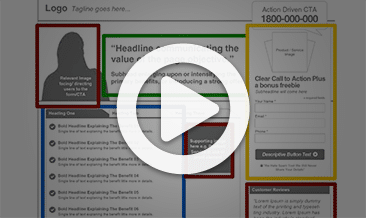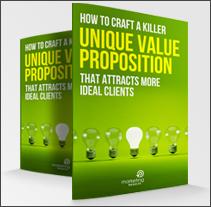“How To Delight Customers and Fatten Your Bottom Line With Marketing Automation”
“Marketing Automation” has become a hot buzzword. Everybody’s talking about it. Not as many are actually doing it. And still fewer are seeing bottom-line results. Marketing Results has helped dozens of companies implement major marketing automation projects using Infusionsoft since 2009 (as well as advising others using other marketing automation platforms). Here are 11 things we’ve learned in the process:
1. The #1 principle of Marketing Automation:
Marketing automation relies on the principle, “Automate the automate-able and free up your people to do what people do best.”
Your people have the capacity to excel at functions like strategy, sales and service. And yet they are often drawn away from their highest and best use by lower value tasks such as manual prospecting, manual-followup, fulfilling sales documentation and speaking with unqualified prospects.
You may also be frustrated because too many items on your “Important But Not Urgent” list just never get done. Things like: ensuring prospects are sales-ready before speaking with them; systematically gathering testimonials; driving customer referrals; and proactively up-selling and cross-selling to your existing customer base.
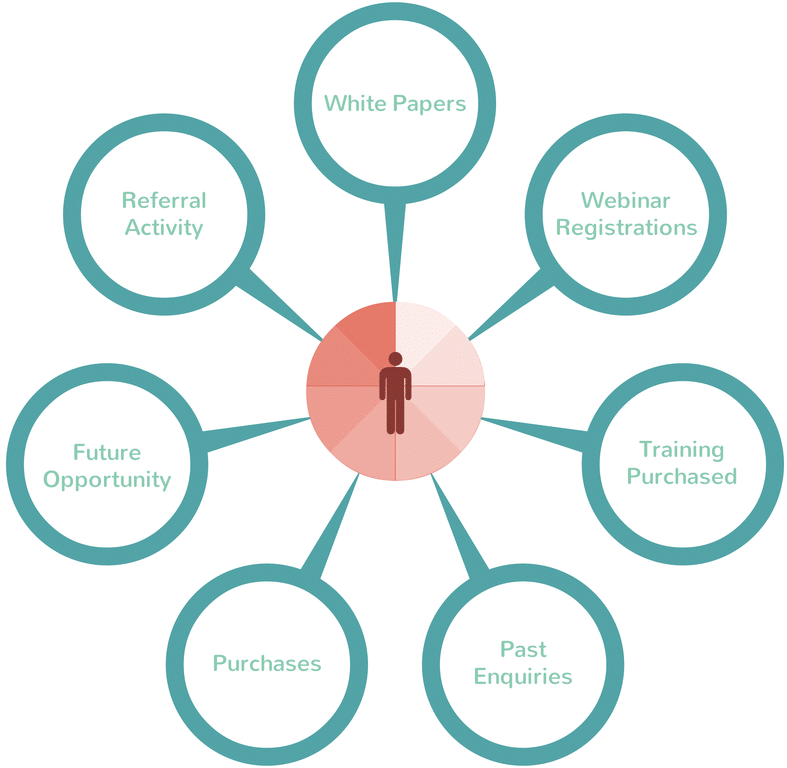
2. 360-degree view of the customer
Marketing automation should ideally give you a 360-degree view of each prospect or customer. In other words, one single view of each customer where you can see EVERYTHING they’ve ever done with you… from downloading a white paper, to attending a free event, to purchasing a paid webinar, to speaking to your sales team, to becoming a customer.
Many companies have one system for email marketing and a different system for handling their sales process.
And because the two systems don’t talk, existing customers on the email newsletter list receive invitations to become a client. Or, people who have unsubscribed in one system continue to get messages from the other system. This is annoying at best and a potential SPAM Act violation at worst.
When you integrate your entire marketing process into ONE system, you’re on the road to ensuring all customers and prospects can receive a customised and relevant experience.
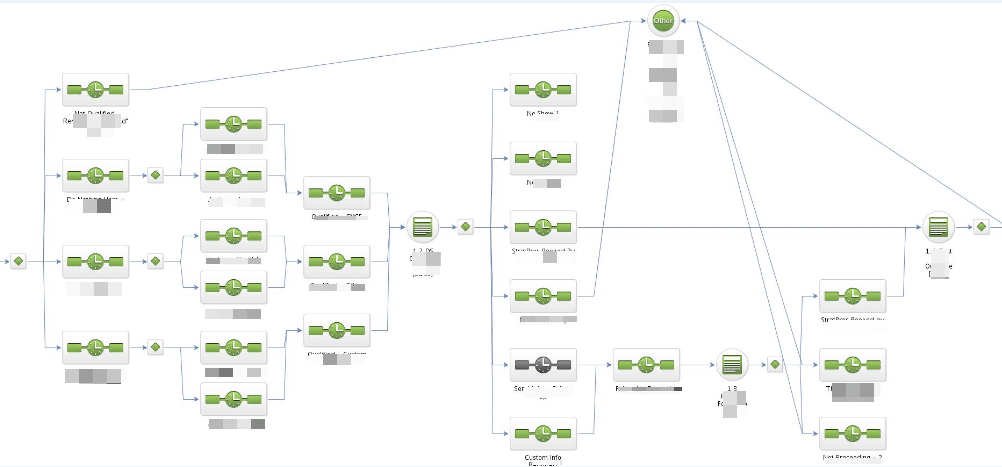
3. Map it on paper first.
It’s easy to get excited by a new piece of software and start throwing data into your system (if you can get your data in in the first place).
But it’s important to remember that any software system is just a tool to facilitate your strategy. You need to know what that strategy actually is first.
Mapping processes in “flowchart” format is a good way to start.
Sense-check before building.
4. What NOT to automate.
Strategy, consultative sales and high-touch service are three things NOT to automate.
When it comes to lead generation, a common mistake is to make the prospect fill in too much information. You might be doing it because you want your marketing automation system to do more of the heavy lifting. But this can end up becoming off-putting to the prospect.
A better approach is usually to ask for only a little information at first, which you add to over time in order to build up a full profile of each prospect and client in a way that adds, not detracts from the process.
5. It’s NOT about the software
When business people start looking at marketing automation, they tend to focus on the price and features of the different programs they may be considering.
But the software aspect is responsible for only a small fraction of the overall success or failure of a marketing automation project.
The other aspects that influence success to an equal or greater degree than the software are your strategy, your marketing funnel, your content, your sales process, team training, user acceptance and on ongoing development plan.
6. Select the right software
That being said, the wrong software can really put a spanner in the works. Software selection mistakes tend to fall into the following categories:
- The software is too simple: for example, an autoresponder system may be able to handle email marketing, but not your sales process, or trigger-based marketing to existing clients
- The software is too complicated: for example, if your main goal is profit-generation via sales and marketing, you may not need a system that handles project management or billing.
- The software is too “enterprise”: other software programs are well-known, and potentially easy to use… but getting the power you need requires a six-figure investment. And that same power is available out of the box from other systems that are a fraction of the cost.
The marketing automation platform we specialise in is Infusionsoft.
It’s not right for every business, but it does offer a lot of power and functionality for businesses with revenue of up to about $20 million, who have a lead-and-sales process, or who sell information online.
If you have an e-commerce store with more than 20 SKUs, or you have a large organisation with a large and complex sales structure (multiple locations, divisions, territories etc.), then I would suggest Infusionsoft is NOT the best solution.
7. Content is critical
Much of marketing automation involves delivering the right message to the right prospect at the right time. This means you need content. A lot of it.
Your content production capacity needs to match your capacity to deliver that content.
Most companies who have a marketing automation tool only get a fraction of the value out of their system because they don’t have enough content to plug in.
8. Sequence is important
The right content needs to be delivered in the right sequence in order to maximise impact.
The “Buyer’s Journey” describes the process of a prospect moving through the stages of AWARENESS to CONSIDERATION to DECISION. Content that aligns with that journey is most effective at generating qualified, sales-ready leads.
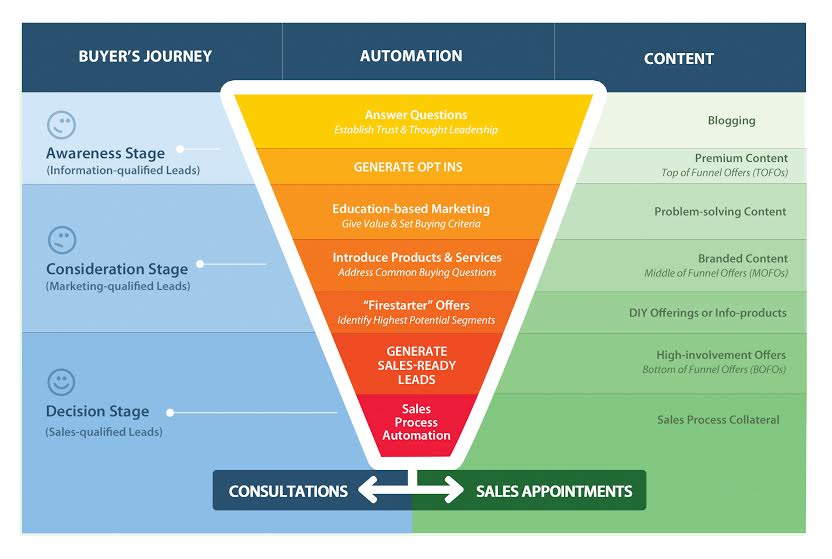
9. Be hyper-relevant
Survey, track and segment prospects so you know how to be more relevant.
For example, one of our financial services clients asks prospects early in the process if they already have a Self-Managed Super Fund.
If they answer “yes”, they receive information on “How to get better returns from your Self-Managed Super Fund”.
If they answer “no”, they get information on “How to set up your own Self-Managed Super Fund”.
Asking simple questions like this, and acting on that information, is much better than collecting reams of data you never do anything with.
Increased relevance gets more Attention, Interest, Desire and Action – all things that marketers want more of!
10. Build in manageable chunks
Just like Rome, your marketing automation function won’t be built in a day.
The key is to build and release small “chunks”, each one adding value to the system as a whole.
This avoids the problem of having a marketing automation system with 20 components that are all half-complete.
Contrast that with a system with 20 components, of which 10 are completely finished and released. The same amount of work has been done, but much more value has been delivered.
11. Ten marketing automation chunks that add value
Here are ten campaign “chunks” that liberate the most value, listed in the order in which we would recommend rolling them out:
- Capturing email addresses or other “soft leads” via a White Paper or other Top of Funnel Offer
- Following up soft leads with drip email marketing campaigns to nurture them toward an enquiry
- Automating your sales opportunity pipeline
- Tagging your contact list with relevant segment labels, and serving customised content relevant to each segment
- Stepping up soft leads toward sales readiness with low-ticket products (e.g. information products that offer a DIY solution)
- Post-purchase follow up sequences to aid customer acceptance and satisfaction, and reduce complaints or refunds
- Testimonial-gathering
- Referral-gathering
- Transitioning clients to higher levels of engagement and expenditure with you
- Extra-special campaigns for “top 4%” clients
Is this all we know?
These principles apply to most marketing automation scenarios for companies with less than $20 million in revenue. But not to all.
Marketing Results has developed specialised expertise in analysing marketing automation requirements; troubleshooting projects that have become “derailed”; and in planning and executing new initiatives that achieve bottom-line financial results.
We provide the interlocking components of strategy, funnel design, content creation, technical integration and analytics in order to deliver solutions that reduce cost, boost revenue and delight customers all at the same time.
The first step to determine “fit” is to set up an obligation free discussion via telephone to discuss the challenges and goals you have in this area. With less than an hour on the phone, we’ll be able to understand whether or not we can help, and if so, how.
